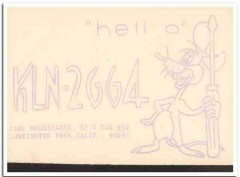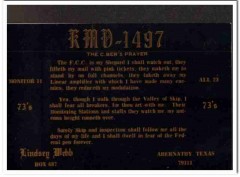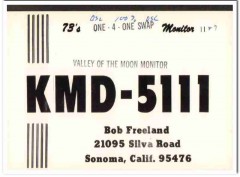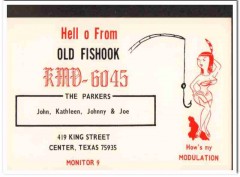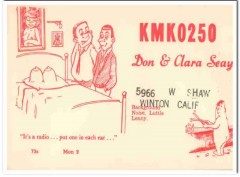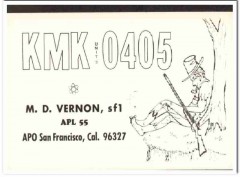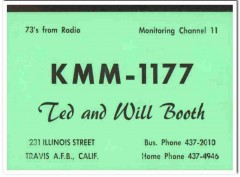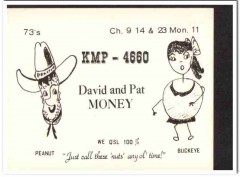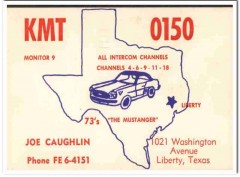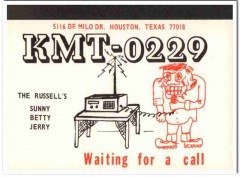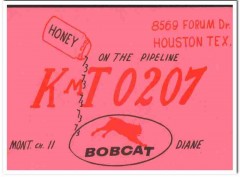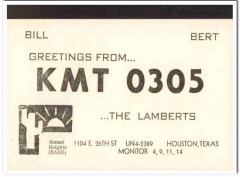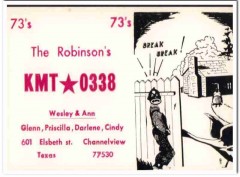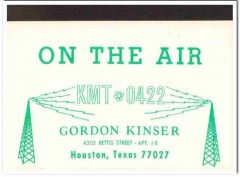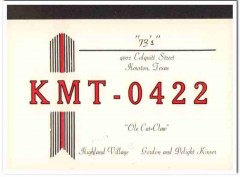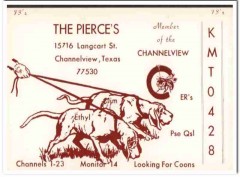QSL Cards
Ham CB SWL QSL Postcards
During the 1920s and 1930s, amateur ham radio operators adopted the practice of two-way exchanging of QSL postcards, to confirm their radio contact, with a report of reception. QSL cards got to be known as wallpaper, commonly used to decorate the walls of their radio equipment room. During the 1960s, CB citizen band radio became popular, and the practice of exchanging QSL cards to confirm radio contacts was enjoyed by many with this new hobby. Many cards have mention of children, refered to as background noise. Some taunt the FCC about then rules and regulations.About 2005, we bought a very large collection of QSL cards from the estate of the late Henry C. Tadrzenski, KMA-4245, from Bristol, CT. At the time, we looked at them, we sorted them by states, and then re-stored them until now. Henry was an avid user of Citizens Band radio, back in the mid 1960's. He traded bundles of cards with everyone, most times without making radio contact, and accumulated over 15,000 cards. All of the cards appear to be from the same time period, from about 1965-1969. Some cards have a 4 or 5 cent stamp and postmark, and some may just be noted with a date and comments about radio equipment. Some cards have pre-zipcode zone numbers, and some have letters in their telephone number. A few even have notice of their old original CB call sign that was change to the newer assignment, back in the early 1960's. Today, these cards are very collectible and look great matted and framed.
KLN-2664 Bruseraber Huntington Park Cal 1960s Vintage Postcard CB QSL
Original QSL postcard from the mid to late 1960s.This unused card was sent from CB radio station: KLN-2664 more. Was issued to Cael Bruseraber, of Huntington Park, California. Card has a cartoon image of a mouse holding a screwdriver. During the 1920s and 1930s, amateur ham radio operators adopted the practice of two-way exchanging of QSL postcards, to confirm their radio contact, with a report of reception. QSL cards got to be known as wallpaper, commonly used to decorate the walls of their radio equipment room. During the 1960s, CB citizen band radio became popular, and the practice of exchanging QSL c less
$14.00 $10.50
KMD-1497 Lindsey Webb Abernathy TX 1960s Vintage Postcard CB QSL Card
Original QSL postcard from the mid to late 1960s.This card was sent from CB radio station: KMD-1497 more. Was issued to Lindsey Webb, of Abernathy, Texas. The C.B.ers Prayer. Skip. FCC. During the 1920s and 1930s, amateur ham radio operators adopted the practice of two-way exchanging of QSL postcards, to confirm their radio contact, with a report of reception. QSL cards got to be known as wallpaper, commonly used to decorate the walls of their radio equipment room. During the 1960s, CB citizen band radio became popular, and the practice of exchanging QSL cards to confirm radio contacts was enjoyed less
$14.00 $10.50
KMD-5111 Bob Freeland Sonoma CA 1960s Vintage Postcard CB QSL Card
Original QSL postcard from the mid to late 1960s.This unused card was sent from CB radio station: KMD-5111 more. Was issued to Bob Freeland, at 21095 Silva Road, Sonoma, California. Valley of the Moon Monitor. White card with black text. During the 1920s and 1930s, amateur ham radio operators adopted the practice of two-way exchanging of QSL postcards, to confirm their radio contact, with a report of reception. QSL cards got to be known as wallpaper, commonly used to decorate the walls of their radio equipment room. During the 1960s, CB citizen band radio became popular, and the practice of exchanging QS less
$14.00 $10.50
KMD-6045 John Parker Center Texas 1960s Vintage Postcard CB Radio QSL
Original QSL postcard from the mid to late 1960s.This card was sent from CB radio station: KMD-6045 more. Was issued to Kathleen and John Parker, at 419 King Street, Center, Texas. His CB handle was Old Fishook. Childrens names are Johnny and Joe. Hell o From Old Fishook. During the 1920s and 1930s, amateur ham radio operators adopted the practice of two-way exchanging of QSL postcards, to confirm their radio contact, with a report of reception. QSL cards got to be known as wallpaper, commonly used to decorate the walls of their radio equipment room. During the 1960s, CB citizen band radio became less
$14.00 $10.50
KMK-0250 Don Seay Winton CA 1960s Vintage Postcard CB QSL Card
Original QSL postcard from the mid to late 1960s.This unused card was sent from CB radio station: KMK0250 more. Was issued to Clara and Don Seay, at 5966 West Shaw Avenue, Winton, California. Child name is Luttle Lenny Seay. Hard-To-Find suggestive cartoon card. Caption reads Its a radio, put one in each ear. Has a long note on the back from Don to Henry, about the card he collects. Also mentioned that he, Don, has 15,000 cards in circulation. This card is one of them. During the 1920s and 1930s, amateur ham radio operators adopted the practice of two-way exchanging of QSL postcards, to confirm their ra less
$24.00 $18.00
KMK-0405 M D Vernon San Francisco CA 1960s Vintage Postcard CB QSL
Original QSL postcard from the mid to late 1960s.This unused card was sent from CB radio station: KMK-0405 more. Was issued to M.D. Vernon, sf1, APL 55, APO San Francisco, California. Unit 3. During the 1920s and 1930s, amateur ham radio operators adopted the practice of two-way exchanging of QSL postcards, to confirm their radio contact, with a report of reception. QSL cards got to be known as wallpaper, commonly used to decorate the walls of their radio equipment room. During the 1960s, CB citizen band radio became popular, and the practice of exchanging QSL cards to confirm radio contacts was enjoyed less
$14.00 $10.50
KMM-1177 Ted Booth Travis Afb CA 1960s Vintage Postcard CB QSL Card
Original QSL postcard from the mid to late 1960s.This unused card, dated 1965, was sent from CB radio station: KMM-1177 more. Was issued to Will and Ted Booth, at 321 Illinois Street, Travis A.F.B., California. Green card with black text. Has a business and home number. Business name unknown. During the 1920s and 1930s, amateur ham radio operators adopted the practice of two-way exchanging of QSL postcards, to confirm their radio contact, with a report of reception. QSL cards got to be known as wallpaper, commonly used to decorate the walls of their radio equipment room. During the 1960s, CB citizen band radio became less
$14.00 $10.50
KMP-4660 David Money Wichita Falls Texas 1960s Vintage Postcard CB QSL
Original QSL postcard from the mid to late 1960s.This card was sent from CB radio station: KMP-4660 more. Was issued to Pat and David Money, at 2171 Avenue J, Wichita Falls, Texas. His CB handle was Peanut, and her CB handle was Buckeye. Just Call These Nuts Any Ol Time! During the 1920s and 1930s, amateur ham radio operators adopted the practice of two-way exchanging of QSL postcards, to confirm their radio contact, with a report of reception. QSL cards got to be known as wallpaper, commonly used to decorate the walls of their radio equipment room. During the 1960s, CB citizen band radio became less
$14.00 $10.50
KMT-0150 Joe Caughlin Liberty Texas 1960s Vintage Postcard CB QSL Card
Original QSL postcard from the mid to late 1960s.This used card, postmarked 1966, was sent from CB radio station: KMT-0150 more. Was issued to Joe Caughlin, at 1021 Washington Avenue, Liberty, Texas. His CB handle was The Mustanger. During the 1920s and 1930s, amateur ham radio operators adopted the practice of two-way exchanging of QSL postcards, to confirm their radio contact, with a report of reception. QSL cards got to be known as wallpaper, commonly used to decorate the walls of their radio equipment room. During the 1960s, CB citizen band radio became popular, and the practice of exchanging QSL cards to confirm ra less
$14.00 $10.50
KMT-0229 Sunny Russell Houston TX 1960s Vintage Postcard CB QSL Card
Original QSL postcard from the mid to late 1960s.This card was sent from CB radio station: KMT-0229 more. Was issued to Betty and Sunny Russell, at 5116 De Milo Drive, Houston, Texas. Waiting For A Call. Child name Jerry Russell. During the 1920s and 1930s, amateur ham radio operators adopted the practice of two-way exchanging of QSL postcards, to confirm their radio contact, with a report of reception. QSL cards got to be known as wallpaper, commonly used to decorate the walls of their radio equipment room. During the 1960s, CB citizen band radio became popular, and the practice of exchanging QSL less
$14.00 $10.50
KMT-0270 Diane Bobcat Houston Texas 1960s Vintage Postcard CB QSL Card
Original QSL postcard from the mid to late 1960s.This unused card was sent from CB radio station: KMT-0207 more. Was issued to Diane (last name unknown), at 8569 Forum Drive, Houston, Texas. Her CB handle was Bobcat. Honey On The Pipeline. During the 1920s and 1930s, amateur ham radio operators adopted the practice of two-way exchanging of QSL postcards, to confirm their radio contact, with a report of reception. QSL cards got to be known as wallpaper, commonly used to decorate the walls of their radio equipment room. During the 1960s, CB citizen band radio became popular, and the practice of exchanging less
$14.00 $10.50
KMT-0305 Bert Bill Lambert Houston Texas 1960s Vintage Postcard CB QSL
Original QSL postcard from the mid to late 1960s.This unused card was sent from CB radio station: KMT-0305 more. Was issued to Bert and Bill Lambert, at 1104 East 26th Street, Houston, Texas. Sunset Heights Base. During the 1920s and 1930s, amateur ham radio operators adopted the practice of two-way exchanging of QSL postcards, to confirm their radio contact, with a report of reception. QSL cards got to be known as wallpaper, commonly used to decorate the walls of their radio equipment room. During the 1960s, CB citizen band radio became popular, and the practice of exchanging QSL cards to confirm radio less
$14.00 $10.50
KMT-0338 Wesley Robinson Channelview TX 1960s Vintage Postcard CB QSL
Original QSL postcard from the mid to late 1960s.This unused card was sent from CB radio station: KMT-0338 more. Was issued to Ann and Wesley Robinson, at 601 Elsbeth Street, Channelview, Texas. Children names are Glenn, Priscilla, Darlene and Cindy. Black memorabilia glory hole. During the 1920s and 1930s, amateur ham radio operators adopted the practice of two-way exchanging of QSL postcards, to confirm their radio contact, with a report of reception. QSL cards got to be known as wallpaper, commonly used to decorate the walls of their radio equipment room. During the 1960s, CB citizen band radio became less
$25.00 $18.75
KMT-0422 Gordon Kinser Houston Texas 1960s Vintage Postcard CB QSL 1
Original QSL postcard from the mid to late 1960s.This unused card was sent from CB radio station: KMT-0422 more. Was issued to Gordon Kinser, at 4303 Bettis Street, Apt #8, Houston, Texas. On The Air. During the 1920s and 1930s, amateur ham radio operators adopted the practice of two-way exchanging of QSL postcards, to confirm their radio contact, with a report of reception. QSL cards got to be known as wallpaper, commonly used to decorate the walls of their radio equipment room. During the 1960s, CB citizen band radio became popular, and the practice of exchanging QSL cards to confirm radio contacts was less
$14.00 $10.50
KMT-0422 Gordon Kinser Houston Texas 1960s Vintage Postcard CB QSL 2
Original QSL postcard from the mid to late 1960s.This unused card was sent from CB radio station: KMT-0422 more. Was issued to Delight and Gordon Kinser, at 4002 Colquitt Street, Houston, Texas. Highland Village. His CB handle was Ole Cat-Claw. During the 1920s and 1930s, amateur ham radio operators adopted the practice of two-way exchanging of QSL postcards, to confirm their radio contact, with a report of reception. QSL cards got to be known as wallpaper, commonly used to decorate the walls of their radio equipment room. During the 1960s, CB citizen band radio became popular, and the practice of exchan less
$14.00 $10.50
KMT-0428 Jim Pierce Channelview Texas 1960s Vintage Postcard CB QSL
Original QSL postcard from the mid to late 1960s.This unused card was sent from CB radio station: KMT-0428 more. Was issued to Ethyl and Jim Pierce, at 15716 Langcart Street, Chanelview, Texas. Looking For Coons. During the 1920s and 1930s, amateur ham radio operators adopted the practice of two-way exchanging of QSL postcards, to confirm their radio contact, with a report of reception. QSL cards got to be known as wallpaper, commonly used to decorate the walls of their radio equipment room. During the 1960s, CB citizen band radio became popular, and the practice of exchanging QSL cards to confirm radio less
$14.00 $10.50
